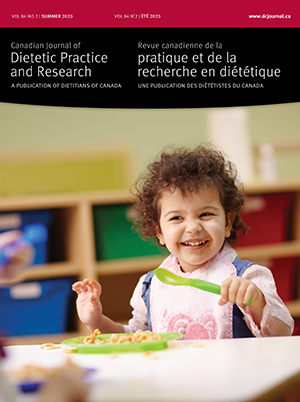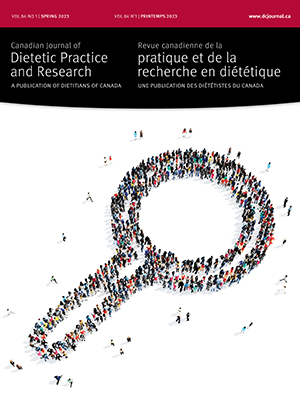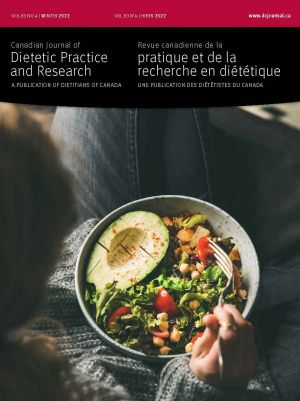Volume 73 • Number 3 • September 2012
Chair’s Message
Editor’s Message
Research
Purpose: Perceptions about males within the dietetic profession were examined among students enrolled in dietetic programs. Methods: A survey was administered in classes or online to first- and fourth-year nutrition students in seven dietetic programs. Data were subjected to content analysis to determine why students thought more males were not choosing dietetics as a career, and what impact an increase in males choosing dietetics might have on the profession. Results: Barriers to career choice were primarily gendered. Respondents believed an increase in male dietitians would be positive, increasing professional diversity. Specifically, more male role models would reach more male clients and increase male interest in dietetics as a career. Students also foresaw improved professional status, leading to greater professional respect and credibility. Current stereotyping would be challenged. Perspectives revealed heteronormative assumptions that would influence recruitment strategies. Conclusions: The findings suggest that broadening the current sex composition of the profession could be beneficial. Attitudes and practices from inside and outside the dietetic profession can influence career choice. Further research would allow a more nuanced approach to the complex and interrelated issues associated with sex and gendered behavior as they relate to the professional complement.
Purpose: To elucidate the complex phenomenon of dietitian professional socialization, we examined factors that influence people’s decisions to pursue a career in dietetics and how education and training processes influence the professional socialization of dietitians. Methods: Participants (n=12) had less than three years of work experience and included alumni from three Canadian universities representing different models of entry to practice. Three one-on-one interviews were conducted with each participant. Results: The key influencing factor in participants’ decision to pursue dietetics was the perceived congruence between dietetics and other aspects of their lives, including early interests and experiences (sports, food and cooking, an eating disorder), career aspirations (science, health care), and social networks (the desire to be a professional). A pivotal experience during high school or while enrolled in or after graduation from another program prompted participants’ awareness of and subsequent decision to pursue a career in dietetics. Supportive relationships were vital to participants’ professional socialization. Conclusions: Recruitment materials and education opportunities should help aspiring dietitians develop a clear idea of what being a dietitian means. Dietetic educators must attend to the informational and relational aspects involved in shaping future practitioners’ dietitian identities.
Purpose: Patients’ perceptions of preventive lifestyle in primary care practice were examined. Methods: Practice was assessed with a modified version of the Primary Care Assessment Survey (PCAS). This was mailed to random samples of patients twice, using practice mailing lists from three Ontario Family Health Networks (FHNs). Family Health Networks are physician-based group practices, with additional nurse-led telephone advisory services to provide care 24 hours a day, seven days a week. The PCAS questionnaire consisted of nine scales (ranging from 0 to 100). For preventive counselling, additional questions on diet and exercise counselling were included to determine how the physician delivered the intervention. Results: Of the 2184 survey questionnaires mailed to patients, 22% were undeliverable. The response rate was 62% at valid addresses (49% of all mailed questionnaires). Of the nine scales, scores (± standard deviation) for preventive counselling were lowest at 33 ± 25. In particular, rates of diet (37%) and exercise (24%) counselling were low in the FHNs. For most other aspects of primary care services, patients generally rated FHNs highly. The majority of patients advised about diet and exercise were given verbal advice or pamphlets. Conclusions: In these primary health care organizations, considerable room exists for increased preventive counselling, especially about diet and exercise.
Purpose: The association between medical, social, and nutritional factors and iron deficiency anemia was examined in adult women who had tested positive for human immunodeficiency virus (HIV) and were living in the Greater Vancouver Area. Methods: This was a cross-sectional observational study of 102 HIV-positive women, aged 19 or older, who were patients of one of three chosen community health clinics in Vancouver, British Columbia. Information on usual dietary intake and other nutrition-related factors was collected with a short diet survey, while medical information and laboratory data were obtained from each participant’s medical chart. Results: Of the predictors studied, a CD4 cell count below 200 cells/µL, a regular menstrual pattern, and African ethnicity were associated with an increased risk of iron deficiency anemia. Dietary intake was not independently associated with iron status. Conclusions: Iron deficiency anemia in HIV-positive women has multifactorial and complicated causation, but is strongly associated with poorer immune status and greater menstrual losses. Health disparities in Aboriginal and African women may lead to a higher risk for iron deficiency anemia. Routine screening and ongoing nutrition education are necessary for the prevention and management of iron deficiency anemia. Further research into factors associated with iron deficiency anemia is essential to improve prevention and management efforts.
Purpose: Determinants of self-efficacy related to food preparation using store-bought food were examined in women belonging to the Atikamekw Nation. Also examined was whether self-efficacy was associated with household food insecurity. Methods: A cross-sectional survey was conducted with 107 women responsible for household food supplies. Two selfefficacy scores were calculated, one for healthy food preparation and one for food preparation in general. Household food insecurity was measured with an adapted version of the United States Food Security Core Module. The other variables were household composition, income sources, food supplies, tobacco use, participants’ health status, and lifestyle and sociodemographic characteristics. Multiple linear regression was used to analyze associations between self-efficacy and household food insecurity in 99 participants. Results: Severe household food insecurity was associated with significantly lower healthy food preparation scores in Atikamekw women. Other associated variables were food supplies, marital status, alcohol consumption, weight status, and understanding of the native language. Conclusions: Application of the concept of self-efficacy contributes to a better understanding of the factors influencing food preparation in Atikamekw women. In this study, self-efficacy in healthy food preparation was linked to food insecurity and obesity, particularly in the most serious cases. Efforts to improve diet will require not only behavioural interventions, but public policies.
Purpose: The prevalence of adult-level household food insecurity was examined among clients receiving outpatient diabetes health care services. Methods: Participants were adults diagnosed with diabetes mellitus, who attended individual counselling sessions at Calgary's main clinic from January to April 2010. Clinicians were trained to administer the Household Food Security Survey Module (HFSSM), and did so with clients’ assent during their scheduled sessions. Results: The prevalence of adult-level household food insecurity among 314 respondents was 15.0% (95% confidence interval [CI], 11.2 to 19.4); 6.7% (95% CI, 4.2 to 10.0) of clinic attendees were categorized as severely food insecure. The comparable rates obtained in Alberta in 2007 using the same instrument (HFSSM) were 5.6% and 1.2%, respectively. Conclusions: Household food insecurity rates among individuals with diabetes in active care are higher than rates reported in Canadian population surveys. Severe food insecurity, indicating reduced food intake and disrupted eating patterns, may affect this population's ability to follow a pattern of healthy eating necessary for effective diabetes management. This study reinforces the importance of assessing clients’ inability to access food because of financial constraints, and indicates that screening with a validated measure may facilitate identification of clients at risk.
Review
Nutrition applications for mobile devices (e.g., personal digital assistants, smartphones) are becoming increasingly accessible and can assist with the difficult task of intake recording for dietary assessment and self-monitoring. This review is a compilation and discussion of research on this tool for dietary intake documentation in healthy populations and those trying to lose weight. The purpose is to compare this tool with conventional methods (e.g., 24-hour recall interviews, paperbased food records). Research databases were searched from January 2000 to April 2011, with the following criteria: healthy or weight loss populations, use of a mobile device nutrition application, and inclusion of at least one of three measures, which were the ability to capture dietary intake in comparison with conventional methods, dietary self-monitoring adherence, and changes in anthropometrics and/or dietary intake. Eighteen studies are discussed. Two application categories were identified: those with which users select food and portion size from databases and those with which users photograph their food. Overall, positive feedback was reported with applications. Both application types had moderate to good correlations for assessing energy and nutrient intakes in comparison with conventional methods. For self-monitoring, applications versus conventional techniques (often paper records) frequently resulted in better self-monitoring adherence, and changes in dietary intake and/or anthropometrics. Nutrition applications for mobile devices have an exciting potential for use in dietetic practice.
Report
Purpose: We explored the eating habits of Arab immigrants to determine whether they have maintained their traditional diet or have consumed a more Westernized diet since immigrating to Canada. Methods: Arab immigrants who had been in Canada for at least eight years and were currently living in the Greater Toronto Area were recruited. A sample of 24 Arab immigrants completed a mailed, self-administered questionnaire, and six participated in a focus group. The focus group discussion was transcribed verbatim and results were recorded. Latent content analysis was used to analyze, code, and categorize emerging themes. Results: Arab immigrants consumed a mixture of both Arabic and Western food and perceived their current diet to be healthier than it was before they immigrated to Canada. Factors that influenced their food choices included increased nutrition health awareness, differences in food preferences and preparation methods, and preservation of dietary practices in the new environment. Conclusions: Our findings will help dietitians who work with Arab immigrants to become more aware of factors that motivate this group's food choices, and to create nutrition programs that are more culturally sensitive.
Recognition
OPEN ACCESS
It is important to step out and make a difference. We have one of the most unique and diverse professions that allows for diversity in thought and practice, permitting each of us to grow in our unique niches and make significant contributions. I was frightened to ‘step out’ to go to culinary school at the age of 46, but it changed forever the way I look at my profession and I have since experienced the most enjoyable and innovative career. There are also times when it is important to ‘step back’ to relish the roots of our profession; to help bring food back into nutrition; to translate all of our wonderful science into a language of food that Canadians understand. We all need to take time to ‘just stand still and breathe’: to celebrate our accomplishments, reflect on our actions, ensure we are heading toward our vision, keep the profession vibrant and relevant, and cherish one another.
Canadian Foundation for Dietetic Research
OPEN ACCESS
Welcome to Toronto! On behalf of the Canadian Foundation for Dietetic Research, it is my great pleasure to welcome you to the 2012 Dietitians of Canada Annual Conference Research Event. This preeminent event represents the breadth and depth of dietetic research in Canada. This year we had a record-breaking number of almost 100 abstract submissions! This exemplifies the strong and significant role dietitians are playing in the research community to support all areas of dietetic practice. To date, we already have over 950 delegates attending the conference with 36 oral presentations and over 50 research posters. The abstracts cover topics including clinical nutrition, communitybased nutritional care, nutrition needs of vulnerable groups, wellness and public health, dietetic practice and education, and food safety and policy. The broad spectrum of topics is one of the exciting aspects of our profession. This will surely be a great opportunity to reacquaint yourself with old friends and to meet new colleagues through your common research interests and practice. I wish to acknowledge and congratulate all the presenters and co-authors for all their hard work and for sharing their research. New to this year’s event will be the electronic poster sessions, which is based on the popular Poster Tours from previous years. Each presenter will speak about the highlights of his/her research while the presenter’s poster is projected on to a large LCD screen. On behalf of the membership of Dietitians of Canada, I would like to thank the Abstracts Review Committee members who took time out of their busy schedules to volunteer their expertise in reviewing the abstracts. Our Abstracts Review Committee represented a broad spectrum of dietetic expertise and professional practice. I wish to thank them for their tremendous effort and contribution. Thank you to: Beth Armour from PEN of Dietitians of Canada, Dr. Pauline Darling from St. Michael’s Hospital and the University of Toronto, Dr. Alison Duncan from the University of Guelph, Mahsa Jessri from the University of Alberta, Christine Mehling from EatRight Ontario, and Dawna Royall from the Canadian Journal of Dietetic Practice and Research. I would also like to acknowledge the following individuals who will assist with moderating the oral and poster sessions in conjunction with the Committee members. Thank you to: Barb Anderson, Isla Horvath, Jane Thirsk, and Pat Vanderkooy. A special thank you also goes to Isla Horvath from the Canadian Foundation for Dietetic Research and Diana Sheh from Dietitians of Canada in supporting the Committee in the abstracts review process. Finally, I would like to acknowledge the Canadian Foundation for Dietetic Research and Dietitians of Canada for their ongoing support of research in dietetics and nutrition in Canada and for their mission to foster and support new researchers and dietetic interns in this important area of practice. Please join me in celebrating this exciting event and the research of your fellow colleagues.










